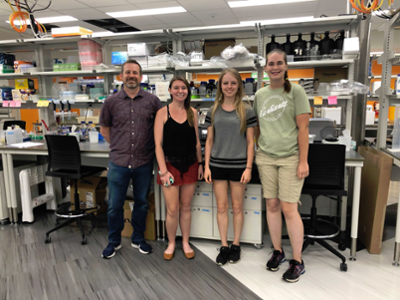Lakes, lasers and a zebrafish: students at Miami Regionals find career and scientific discoveries


(Left to right) Matt Saxton, EEEB Ph.D. candidate Carly Prochazka, and Applied Biology majors Helena Hitch and Emma Jones
By Val Prevish contributor for Miami University Regionals
Three assistant science professors at Miami University Regionals are conducting world class research, offering students a chance to engage in scientific discovery, while also bringing significant funding to the Regionals.
From Great Lakes ecosystems to embryonic heart tissues and plasma physics, these professors are discovering new knowledge that will help bring critical solutions to problems that impact our daily lives, such as congenital heart defects in infants and a lack of clean drinking water. Their work also allows them to share their expertise and experience with students.
Professor of Biology David Berg said Miami offers the extensive opportunities for students to engage in world-class research, but extending this opportunity to regional campus students is what sets Miami apart from many other multi-campus institutions.
“This is unusual for regional campuses,” he said. “It gives students at the Regionals the same opportunities as students on the Oxford campus, which is a huge advantage for our students.”
The assistant professors, profiled below, bring the knowledge and experience generated by their research groups to their classrooms, leading to even richer experiences for science students at Miami. Their work is yet another example of why the Regionals are ranked number one for return on investment among Ohio public colleges.
Matt Saxton shares his love for the Great Lakes with students
Growing up in Tiffin, Ohio, near Sandusky, Matt Saxton, assistant professor in the Department of Biological Sciences, fondly remembers fishing with his dad on Sandusky Bay. The smell of dead fish was an undesirable presence on the bay and something he came to associate with lake water. He would learn later as a graduate student, however, that this smell was a sign the lake was not healthy. The smell wasn’t supposed to be there at all.
His experiences growing up near the Great Lakes were a part of what led him to a career in the biology of freshwater. Today, he is dedicated to the study of healthy ecosystems in the Great Lakes and the prevention of harmful algal blooms that threaten to disrupt those ecosystems. He is part of a team from Miami University conducting research under a two-year $264,000 grant from the Ohio Department of Higher Education Harmful Algal Bloom Research Initiative to provide solutions to this growing threat to the nation’s most valuable fresh water system.
“I always wanted to come back to the Great Lakes region,” said Saxton, after studying and working in other parts of the country. “One of the most exciting things about joining the faculty at the Regionals was the chance to work with established scientists whose work I’ve admired for many years.”
Saxton is referring to Miami University biology professors Craig Williamson and Michael Vanni, who are well known in limnology (the study of lakes) and have conducted important research surrounding the Great Lakes throughout their careers. “A big priority for me as a new Regionals faculty member was to establish a connection with these professors because of their incredible reputations,” said Saxton. “Our work could help find answers to why algal blooms have increased and how to stop them.”
The ODHE Harmful Algal Bloom Research Initiative was launched after the 2014 Toledo water crisis, when algal blooms on Lake Erie threatened the city’s major water source. The crisis illuminated the continued threats to the Great Lakes environment from pollution. Several universities across the state are participating in the project.
The critical research from the team at Miami University and Saxton at Miami Regionals will focus on how organic matter and light combine to provide the perfect environment for harmful algal blooms to form. Miami University doctoral candidate Lauren Knose and Saxton will lead the work in molecular biology.
Saxton says he is thrilled to share his experiences as a researcher with his students at the Regionals, some of whom participate in his lab.
“At many regional (college) programs, this is not an option for students,” said Saxton. “This is possible here at (Miami Regionals) because we are so closely connected to the Oxford campus. It gives us an ability to show students the cutting edge of what’s happening (in limnology). When they have the chance to see the depth of scientific discovery, it’s much different than simply what you’d get out of a textbook.”
Jennifer Schumacher works to unlock the secrets of cell development in the heart
Zebrafish have a unique developmental trait that gives them a fully functioning heart at 24 hours old. This makes them the ideal subjects for critical research in embryonic heart development, said Jen Schumacher, assistant professor in the Department of Biological Sciences. She received more than $411,000 from the National Institutes of Health to study embryonic development in zebrafish. Her work could lead to new treatments for human infants who suffer from congenital heart defects.
“Congenital heart defects are present in one in 100 live births,” said Schumacher. “Most require medical intervention and they can be devastating to babies. We hope that we can learn more about the molecular pathways involved in heart development and extend that knowledge to humans.”
Schumacher’s NIH grant will fund three years of study, and she will work in collaboration with researchers at Cincinnati Children’s Hospital Medical Center. Her lab at Miami combines embryology, molecular biology, genetics, and genome editing techniques to uncover the molecular mechanisms driving how a specific subset of cells in the early embryo is instructed to become endocardium (the inner lining of the heart), and how endocardial cells move to form the proper shape.
In other words, her research will help uncover how the early developing heart forms its shape and how this affects the development of the heart throughout the embryonic phase.
Schumacher says her research impacts her classroom teaching in several ways.
“I just started teaching a course in genetics. I include my research in my lecture and use examples of how this work explains genetics for my students,” she said. “I also offer independent study courses for interested students, and two of my students are research assistants in my lab. This work exposes them to new techniques and shows them the exciting side of medical research.”
Joe Snyder opens pathways to discovery for students
A Miami undergraduate will get an exciting opportunity to participate in a national research project next summer investigating how laser light and its effect on matter can be optimized by machine learning through a grant from the National Science Foundation and the Department of Energy. The research has important implications for biomedical science, defense purposes and industrial uses.
Department of Mathematical and Physical Sciences Assistant Professor Joe Snyder will lead the project for Miami. The Miami student who is selected to participate will have the chance to work in the Extreme Light Lab at the Air Force Institute of Technology in Dayton, the site of groundbreaking national research in laser light science.
“This is a chance for one of our students to get valuable exposure to a potential career path in the sciences that they may not have considered before,” said Snyder. “This type of experience early in their academic career can help them develop the skills that will matter later in furthering their education in computer science, physics or math.”
In addition to Miami Regionals, the project also involves students from The Ohio State University Marion regional campus and from California State University Channel Islands. A major goal of the project is to increase diversity in STEM career paths.
The three-year $750,000 grant funds the investigation of the use of artificial intelligence in the form of a machine learning algorithm to control a laser system. In addition, it will involve splitting a laser pulse into two beams and using constructive interference to potentially double the intensity on a target without requiring additional laser energy. The results from these efforts may have significant impact on the field of proton radiography, which is used widely in medicine as well as in defense and other industries.
Snyder will work to recruit a physics student from Miami Regionals for the position and work closely with the Miami and OSU students in the lab once the research begins. He will also deliver public lectures about the project.
“This is a very exciting chance for one of our students to work in the Extreme Light Lab and then travel to national conferences to present results,” said Snyder. “This could be a career-changing opportunity.”

